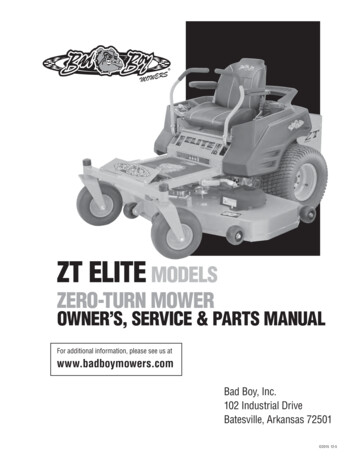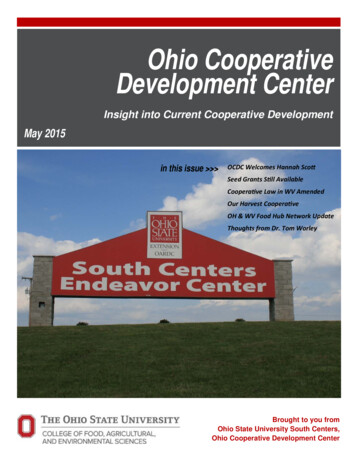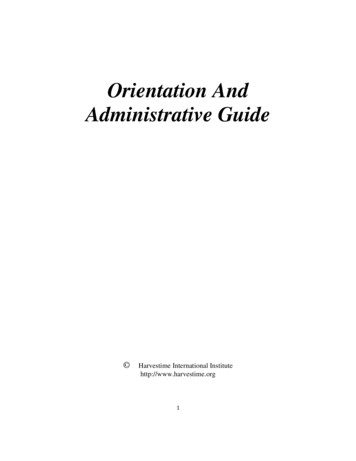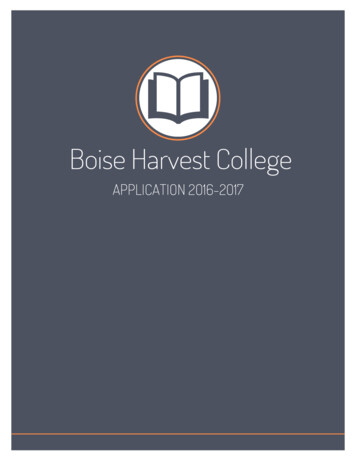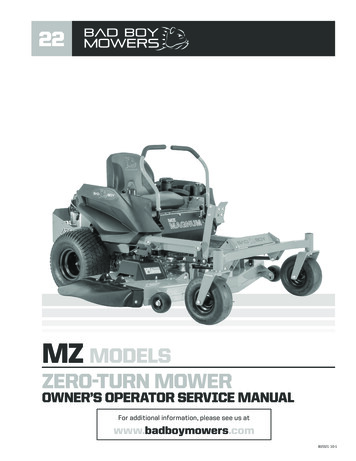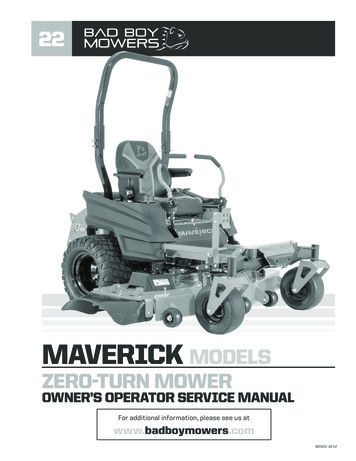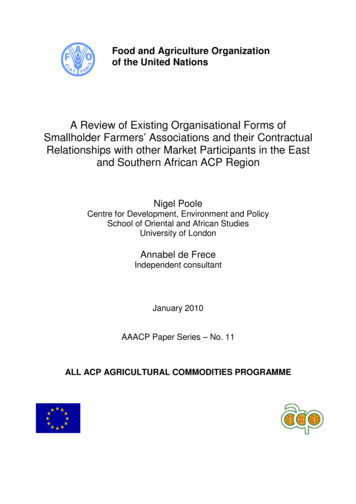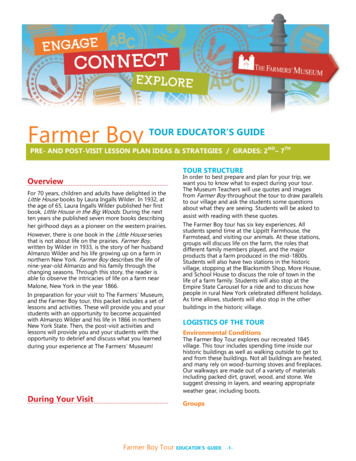
Transcription
Farmer BoyTOUR EDUCATOR’S GUIDEPRE- AND POST-VISIT LESSON PLAN IDEAS & STRATEGIES / GRADES: 2ND– 7THTOUR STRUCTUREOverviewFor 70 years, children and adults have delighted in theLittle House books by Laura Ingalls Wilder. In 1932, atthe age of 65, Laura Ingalls Wilder published her firstbook, Little House in the Big Woods. During the nextten years she published seven more books describingher girlhood days as a pioneer on the western prairies.However, there is one book in the Little House seriesthat is not about life on the prairies. Farmer Boy,written by Wilder in 1933, is the story of her husbandAlmanzo Wilder and his life growing up on a farm innorthern New York. Farmer Boy describes the life ofnine-year-old Almanzo and his family through thechanging seasons. Through this story, the reader isable to observe the intricacies of life on a farm nearMalone, New York in the year 1866.In preparation for your visit to The Farmers’ Museum,and the Farmer Boy tour, this packet includes a set oflessons and activities. These will provide you and yourstudents with an opportunity to become acquaintedwith Almanzo Wilder and his life in 1866 in northernNew York State. Then, the post-visit activities andlessons will provide you and your students with theopportunity to debrief and discuss what you learnedduring your experience at The Farmers’ Museum!During Your VisitIn order to best prepare and plan for your trip, wewant you to know what to expect during your tour.The Museum Teachers will use quotes and imagesfrom Farmer Boy throughout the tour to draw parallelsto our village and ask the students some questionsabout what they are seeing. Students will be asked toassist with reading with these quotes.The Farmer Boy tour has six key experiences. Allstudents spend time at the Lippitt Farmhouse, theFarmstead, and visiting our animals. At these stations,groups will discuss life on the farm, the roles thatdifferent family members played, and the majorproducts that a farm produced in the mid-1800s.Students will also have two stations in the historicvillage, stopping at the Blacksmith Shop, More House,and School House to discuss the role of town in thelife of a farm family. Students will also stop at theEmpire State Carousel for a ride and to discuss howpeople in rural New York celebrated different holidays.As time allows, students will also stop in the otherbuildings in the historic village.LOGISTICS OF THE TOUREnvironmental ConditionsThe Farmer Boy Tour explores our recreated 1845village. This tour includes spending time inside ourhistoric buildings as well as walking outside to get toand from these buildings. Not all buildings are heated,and many rely on wood-burning stoves and fireplaces.Our walkways are made out of a variety of materialsincluding packed dirt, gravel, wood, and stone. Wesuggest dressing in layers, and wearing appropriateweather gear, including boots.GroupsFarmer Boy Tour EDUCATOR’SGUIDE-1-
Typically, we ask that you divide your students in toroughly equal groups of 10-15 prior to arrival, unlessotherwise directed by Education Staff ahead of time.Each group must have at least one adult chaperonewith them at all times. You will tour around theHistoric Village in these groups with a MuseumTeacher, but will rejoin your school as a whole foryour scheduled lunch time.LengthThis tour normally lasts 2 hours, not including alunch break. If you plan to visit for a longer orshorter time, or would like to visit a specific locationat our museum, please contact Education staff.When you ArriveWhen you arrive, your bus should pull into the mainparking lot of The Farmers’ Museum and Museumstaff will greet you. It is important that you bringeverything you will need with you, as the bus will beparked in a lot further down the street and you willnot have access during your visit.Once you have unloaded, you should head to theLouis C. Jones Center (on the right hand side justpast the admissions kiosk as you enter the MainBarn) for orientation and to drop off your lunches.We ask that you leave your lunches, coolers,backpacks, etc., on the table(s) nearest the front ofthe Louis C. Jones Center. At this time, you may alsowant to take a bathroom break as a group prior tostarting your tour. Restrooms are located just insidethe front door in the two large silos.At this time, the lead teacher should check in withour Admissions team. You will be asked for the finaltally of students, one-on-one aides, and adults withyour group; we suggest using your confirmationworksheet as a place to collect all this informationthe morning of your visit. You will also pay at thistime. After you have checked in and your group hasbeen oriented, museum staff will ask you to helpdivide your students into their pre-assigned groups,and you will set out for your tour!Additional InformationPlease consult The Farmers’ Museum TourInformation document that you received, which canalso be found on our website, for additionalinformation concerning the logistics of your visit.developments, and turning points in the history ofthe United States and New York.English Language Arts Common CoreSPEAKING AND LISTENINGComprehension and Collaboration Prepare for and participate effectively in a rangeof conversations and collaborations with diversepartners, express ideas clearly and persuasively,and build on those of others. Integrate and evaluate information presented indiverse media and formats (including visual,quantitative, and oral.) Evaluate a speaker’s point of view, reasoning, anduse of evidence and rhetoric.Presentation of Knowledge and Ideas Present information, findings, and supportingevidence such that listeners can follow the line ofreasoning. Ensure the organization, development,and style are appropriate to task, purpose, andaudience. Make strategic use of digital media and visualdisplays to express information and enhanceunderstanding of presentations. Adapt speech to a variety of contexts andcommunicative tasks, demonstrating command ofacademic English when indicated or appropriate.LANGUAGEVocabulary Acquisition and Use Determine or clarify the meaning of unknown andmultiple-meaning words and phrases by usingcontext clues, analyzing meaningful word parts,and consulting general and specialized referencematerials, as appropriate. Demonstrate understanding of figurativelanguage, word relationships and nuances in wordmeanings. Acquire and use accurately a range of generalacademic and content-specific words and phrasessufficient for reading, writing, speaking, andlistening; demonstrate independence in gatheringand applying vocabulary knowledge whenconsidering a word or phrase important tocomprehension or expression.TOUR LEARNING STANDARDSSocial StudiesSTANDARD 1: HISTORY OF THE UNITED STATESAND NEW YORKUse a variety of intellectual skills to demonstratetheir understanding of major ideas, eras, themes,Pre-Visit Lesson and ActivitiesLESSON ONE: WHO ARE THE WILDERS?OverviewFarmer Boy Tour EDUCATOR’SGUIDE-2-
Laura Ingalls Wilder’s books have been immenselypopular in the decades since her death. This lessonprovides students with the opportunity to becomefamiliarized with Laura Ingalls Wilder, her husbandAlmanzo Wilder, and the Wilder family. Using the NewYork State Historical Association history newsletter,“The Story of Almanzo Wilder: Farmer Boy, Part I,”students will explore the Wilder family’s history, theLittle House series stories, and life on the frontier in thelate 1800s.invited to attend and see and hear what their studentsexperienced while on their field trip.Design an art project that depicts or highlights ameaningful experience from the field trip.Organize a class discussion about the Farmer Boy tourand field trip to The Farmers’ Museum. Discuss field triphighlights, what they learned, what it tells them aboutthe past, and then and now comparisons.LESSON TWO: THEN AND NOW: WHATWAS FARM LIFE LIKE IN 1866 NY?OverviewLaura Ingalls Wilder’s book Farmer Boy provides anexciting glimpse into family and farm life in rural 1866New York State. This lesson offers students theopportunity to understand the life of the Wilder familyas they lived in the small community of Malone, NY.Students will be able to draw comparisons between lifein rural 19th century New York to that of today.LESSON THREE: CHECK THIS OUT: 19THCENTURY PRIMARY SOURCESOverviewHow do we learn about the past? Usually, this is aprocess of research, study, and analysis of sources. Butnot just any sources—primary sources! These firstperson accounts and records provide us with a windowto understand and discover how people lived, worked,and played in the past. This particular activity will helpstudents use primary sources in the context of theFarmer Boy Tour.Post-Visit Lesson and ActivitiesWe hope that you and your students had a memorableand educational experience at The Farmer’s Museum.These lesson and activity ideas can be used to createclosure and serve as an evaluative tool to yourstudents’ learning experience with us.STUDENTS CAN Create a classroom exhibit or bulletin board thatdepicts what students learned about the Laura IngallsWilder and her husband Almanzo, Farmer Boy, and lifein a 19th farming community.Act out a skit or scene that describes the changes fromNew York’s early farming industry to life as we know ittoday.Write a short essay that identifies what studentslearned from their field trip and compare and contrast19th century and 21st century New York in the contextthat they examined at the museum.Present an oral report in small groups that highlightsdifferent ideas or events that they discovered duringtheir time at The Farmers’ Museum; this activity couldbe made into an event in which students’ parents areFarmer Boy Tour EDUCATOR’SGUIDE-3-
Lesson One: Who are the Wilders?OVERVIEWLaura Ingalls Wilder’s books have been immensely popular in the decades since her death. This lesson provides students with the opportunity to become familiarized with Laura Ingalls Wilder, her husband Almanzo Wilder, and theWilder family. Using the New York State Historical Association history newsletter, “The Story of Almanzo Wilder:Farmer Boy, Part I,” students will explore the Wilder family’s history, the Little House series stories, and life on thefrontier in the late 1800s.Learning ObjectivesSTUDENTS WILL Identify the author of Farmer Boy and the other Little House series books.Explain how Farmer Boy is different from Wilder’s other stories.Identify and describe the major locations where Almanzo lived during his lifetime.Describer Almanzo and Laura’s early married years.New York State Learning StandardsENGLISH LANGUAGE ARTS COMMON COREKey Ideas and Details Read closely to determine what the text says explicitly/implicitly and make logical inferences from it; cite specifictextual evidence when writing or speaking to support conclusions drawn from text. Determine central ideas or themes of a text and analyze their development; summarize the key supporting details and ideas.SOCIAL STUDIESStandard 3: Geography Use a variety of intellectual skills to demonstrate their understanding of the geography of the interdependentworld in which we live—local, national, and global—including the distribution of people, places, and environments over the Earth’s surface.READING STANDARDS FOR LITERACY IN HISTORY/SOCIAL STUDIES Cite specific textual evidence to support analysis of primary and secondary sources.ESSENTIAL & TOPICAL QUESTIONSWho was Laura Ingalls Wilder?Where did Almanzo Wilder spend his childhood?What do the Little House series books tell us about life in the 1800s?Are autobiographical stories important and accurate in telling us about history?PROCEDURETo begin, ask students if they know who Almanzo and Laura Wilder are and what they can tell the class about them.You may want to reference the Little House series books or the television show.Ask students if they have ever heard of Wilder’s book Farmer Boy and if they know what makes this one differentfrom the other Little House stories. After any needed discussion, explain that this book was written about her husband Almanzo’s childhood in upstate New York in the year 1866, and not about Ingalls’ life on the prairie.Distribute “The Story of Almanzo Wilder” handout to students. Read the handout together as a class, or divide students into small groups or partners. After reading the newsletter, have students write a essay about the challengesof life in the mid- to late 1800s, citing specific examples from the text of the article or from Farmer Boy. Studentscan also complete the “Farmer Boy Map Activity” that is included in the newsletter.Farmer Boy Tour EDUCATOR’SGUIDE-4-
SUPPLEMENTAL LEARNING OPPORTUNITIESSTUDENTS CAN Read the entire Farmer Boy story as a class.Create a timeline of Almanzo Wilder’s life.Write a biography about Laura, Almanzo, or any of the other family members.Participate in a Read-A-Thon, seeing how many of Laura Ingalls Wilder’s Little House books the class can read in aset time.Farmer Boy Tour EDUCATOR’SGUIDE-5-
Lesson Two: Then and now— what was farm life like in 19thcentury new York state?OVERVIEWLaura Ingalls Wilder’s book Farmer Boy provides an exciting glimpse into family and farm life in rural 1866 New YorkState. This lesson offers students the opportunity to understand the life of the Wilder family as they lived in thesmall community of Malone, NY. Students will be able to draw comparisons between life in rural 19th century NewYork to that of today.Learning ObjectivesSTUDENTS WILL Categorize and describe 19th century farm-related activities and how they correspond to the time of year.Identify and describe the individual roles of 19th century family members during each season.Compare and contrast the daily and seasonal activities on an upstate New York farm during the 1860s with dailyand seasonal activities of today.New York State Learning StandardsENGLISH LANGUAGE ARTS COMMON COREKey Ideas and Details Read closely to determine what the text says explicitly/implicitly and make logical inferences from it; cite specifictextual evidence when writing or speaking to support conclusions drawn from text.SOCIAL STUDIESStandard 1: History of the United States and New York Describe the major social, political, economic cultural, and religious development in New York State and UnitedStates history, as well as the important roles and contributions of individuals and groups Compare and contrast the important ideas, social and cultural beliefs, and traditions from New York State andUnited States history and illustrate the connections and interactions of people and events across time and froma variety of perspectivesREADING STANDARDS FOR LITERACY IN HISTORY/SOCIAL STUDIES Cite specific textual evidence to support analysis of primary and secondary sources.ESSENTIAL & TOPICAL QUESTIONSWhat chores do each of the members of your family do on a daily basis?What different chores does each of the Wilder family members perform?How have daily and seasonal activities of a 19th century farm family changed compared to the daily and seasonalactivities that we have today?If you lived on a 19th century farm, what three words would you use to describe your life and why?PROCEDURETo begin, discuss as a class what students do around the house to help their family. Does each member of thefamily have a specific job? After discussing 21st century household chores with students, ask them if there arespecific jobs that they have during each of the seasons (e.g. shoveling the sidewalk in the winter, raking leaves in thefall, spring cleaning).After discussing the idea of seasonal chores, begin discussing how on the Wilder farm in Malone, New York, eachfamily member had a specific job to do on a daily and seasonal basis. As a class, with a partner, or individually, havestudents read the “Almanzo Wilder and Life on a Farm in 1866” handout.Once students have read the article, they can work on the activity “Seasonal Activities on the Wilder Farm” eitherindividually, with partners, or as a class. Groups could also be divided based on the seasons, with students thensharing their findings with each other.Farmer Boy Tour EDUCATOR’SGUIDE-6-
If desired, students can then work on “Almanzo’s Jigsaw Puzzle” to learn farming terminology and vocabulary.To conclude, the remaining essential and topical questions can be discussed as a class.SUPPLEMENTAL LEARNING OPPORTUNITIESSTUDENTS CAN Read Chapter 2: Winter Evening and describe the Wilder Homestead either through a short writing exercise or visualrepresentation.Create a tool book manual describing and depicting the tools and materials that were used and created on theWilder Homestead.Design a classroom exhibit featuring 19th century farm equipment, tools, and products.Write a short essay comparing 19th century farm life with 21st century life today.Read the entire Farmer Boy story as a class.Farmer Boy Tour EDUCATOR’SGUIDE-7-
Lesson Three: Check this out: 19th century primary sourcesOVERVIEWHow do we learn about the past? Usually, this is a process of research, study, and analysis of sources. But not justany sources—primary sources! These first-person accounts and records provide us with a window to understand anddiscover how people lived, worked, and played in the past. This particular activity will help students use primarysources in the context of the Farmer Boy Tour.Learning ObjectivesSTUDENTS WILL Define what primary source documents are.Interpret and explain what this document tells us about New York State history and culture.New York State Learning StandardsSOCIAL STUDIESStandard 1: History of The United States & New York Describe how ordinary people and famous historic figures in the local community, State, and the United Stateshave advanced the fundamental democratic values, beliefs, and traditions expressed in the Declaration of Independence, the New York State and United States Constitutions, the Bill of Rights, and other important historicdocuments Consider the sources of historic documents, narratives, or artifacts and evaluate their reliability Understand how different experiences, beliefs, values, traditions, and motives cause individuals and groups tointerpret historic events and issues from different perspectives. Describe historic events through the eyes and experiences of those who were there.READING STANDARDS FOR LITERACY IN HISTORY/SOCIAL STUDIES Cite specific textual evidence to support analysis of primary and secondary sources. Determine the central ideas or information of a primary or secondary source; provide an accurate summary ofthe source distinct from prior knowledge or opinions.ENGLISH LANGUAGE ARTS COMMON COREKey Ideas and Details Read closely to determine what the text says explicitly/implicitly and make logical inferences from it; cite specifictextual evidence when writing or speaking to support conclusions drawn from text. Determine the central ideas or themes of a text and analyze their development; summarize the key supportingdetails and ideas.Integration of Knowledge and Ideas (R.7-8) Integrate and evaluate content presented in diverse media and formats. Delineate and evaluate the argument and specific claims in a text, including the validity of the reasoning as wellas the relevance and sufficiency of the evidence.Research to Build and Present Knowledge (W.7) Gather relevant information from multiple sources, assess the credibility and accuracy of each source, and integrate the information in writing while avoiding plagiarism.ESSENTIAL & TOPICAL QUESTIONSWhat is a primary source? What do they tell us?Why are primary sources important?How do historians and museums use primary sources?Farmer Boy Tour EDUCATOR’SGUIDE-8-
PROCEDURETo begin, students should discuss how historians learn and write about the past. Students should discuss whatsources are used and the differences between primary and secondary sources.Using the primary source examples from the Harvest of History website, students will analyze a primary sourceexample with the supplemental worksheet, “Reading a Document”.Note: The teacher may use any primary source that they believe will benefit the class understanding the most. It maybe helpful to analyze one source together as a class, then have students work with a partner or small group toanalyze another.As a form of closure, students can reflect and discuss their findings and the essential questions.SUPPLEMENTAL LEARNING OPPORTUNITIESSTUDENTS CAN Write a diary entry from the perspective of a someone living in 19th century rural New York, using primary sourcesto provide evidence.Design an exhibit that uses the Harvest of History primary sources to tell the story of rural 19th century New York.Analyze a primary source document using the handout as independent practice.Farmer Boy Tour EDUCATOR’SGUIDE-9-
The Story of almanzo wilderMany years ago, during the 1930s, a woman by the name of Laura Ingalls Wilder gave awonderful gift to the world. Mrs. Wilder, then in her sixties, wrote about her girlhood days onthe western prairies of the United States during the late 1800s in the form of the Little Housebooks. There are nine books in Laura’s Little House series. Perhaps you have read some of herstories, like Little House in the Big Woods or Little House on the Prairie.Almost all of Laura Wilder’s stories tell about her girlhood days on the western prairies. Oneof her books, however, tells about her husband, Almanzo Wilder. When Almanzo was a boy,he lived on a farm outside the village of Malone in northern New York State. The book aboutAlmanzo is called Farmer Boy. The story takes place in 1866 on a large farm owned byAlmanzo’s father.In this lesson you will learn about Almanzo Wilder and his family. You will travel withLaura Ingalls Wilder inAlmanzo to each of the places where he lived. The journey begins in northern New Yorkher sixtiesState, where Almanzo was born. From there, you will travel west with Almanzo and his familyto Minnesota. Then you will head further west with Almanzo to the Dakota Territory. It is in the Dakota Territorywhere he marries Laura Ingalls. Finally, you will end your journey inMansfield, Missouri.THE WILDER FAMILY IN NORTHERN NEW YORK STATEAlmanzo James Wilder was born on February 13, 1857, on a farm locatedin Burke, New York. The farm was about twelve miles south of theCanadian boarder and less than five miles east of the village of Malone.Almanzo was the fifth of six children born to James and Angeline DayWilder.The Wilder family had been living in northern New York for about 50years when Farmer Boy took place. Almanzo Wilder’s grandparents, Abeland Hannah Payne Wilder, moved from Vermont to Malone, New York,in 1817. In 1816 harsh weather struck the northeastern United States.That year was known as the year without a summer. In New England,crops failed and many people began to move west.The Wilder Family about 1870 in Malone, New York.Seated left to right: Royal, James (Father), Perley,Angeline (Mother), Alice. Standing: Almanzo, ElizaJane, and Laura.Abel and Hannah settled just outside the small community of Malone, where they built a one-room log cabin.Malone was first settled in 1802 and was a very small village during the early 1800s. Only a few farm houses, logcabins, and just a handful of stores were there at that time.James M. Wilder, Almanzo’s father, was nearly five when his family moved west from Vermont to Malone. By 1840,James had saved enough money to buy farmland located outside of Malone. The farm, which is described in FarmerBoy, originally consisted of 88 acres; later, James bought more land to make his farm larger. In 1843 James Wildermarried Angeline Day of Chateaugay, a neighboring town. Besides raising a family of six children, James andAngeline became successful farmers. Both were skilled, hand-working individuals. James had learned carpentry fromhis father, and Angeline proved to be a good household manager.The red-painted farmhouse, built by James Wilder in the 1840s, still stands today on what is known as Stacy Road.The house and large barns (no longer standing) were located on a hilloverlooking a branch of the Big Trout River. To the north, one could see asilver streak in the distance—this was the St. Lawrence River. To the southwere the foothills of the Adirondack Mountains.Boyhood home of Almanzo Wilder from 1857 to1875In 1866, the year Almanzo Wilder was nine, and the year in which FarmerBoy takes place, Malone was a thriving community of about 6,000 people.Malone, located in Franklin County, had grown following the completion ofthe Northern Railroad in 1850. The Northern Railroad connected RousesPoint with Ogdensburg. Malone, located between these two places, hadbecome an important railroad terminal by the 1860s. This encouraged thegrowth of industry in Malone and it had a number of industries such as amilling, tanning, lumbering, and wool manufacturing. Malone alsomanufactured railroad engines and railroad cars. During the 1860s, thevillage of Malone also supported two banks and two newspapers.Education was important to the people of Malone from its early days. Thefirst school in Malone was established in 1806. In 1831 the school becameFarmer Boy Tour EDUCATOR’SGUIDE-10-
known as the Franklin Academy. Almanzo’s older brother and sisters attended the Franklin Academy. Almanzo wastoo young to go to the Academy before the family moved west to Minnesota. Instead, he went to school about amile south of his home in Burke.THE WILDER FAMILY MOVES WEST TO MINNESOTADuring the early 1870s, James Wilder began to consider a move to the west. Several members of his wife’s family andthe Wilders’ oldest daughter had gone to live in Spring Valley, Minnesota. Spring Valley, located in southeasternMinnesota, is one of the most fertile farming areas in the United States. This was probably a difficult decision forJames and Angeline, since they had lived in new York State most of their lives. But the reports of good farming in theWest convinced them to make the move.In 1872 James and Angeline Wilder and several of their children—Laura, Almanzo, and Perley—were living in SpringValley. Three other children, Royal, Eliza Jane, and Alive, were still living in northern New York State. It was not until1875 that their farm in New York was sold and the entire family could move west to Spring Valley, Minnesota.ALMANZO MOVES WEST TO THE DAKOTA TERRITORYIn 1879, when Almanzo was 22, he left home and moved to western Minnesota to raise seed and wheat. That sameyear, Almanzo and his brother Royal moved further west to the Dakota Territory. There they filed on homesteadclaims near De Smet. De Smet is located in present-day South Dakota. South Dakota didnot become a state until 1889, so it was called the Dakota Territory when Almanzo firstsettled there. It was in De Smet that Almanzo first met Laura Ingalls. Almanzo and Laurawere married on August 25, 1885. At the time of their marriage, Almanzo was 28 years oldand Laura was 18. In December of 1886, their first child, Rose, was born.The years that Almanzo and Laura spent together were often filled with hardship. Laurareferred to their early years together as sunshine and shadow. In 1887 their barn andhaystacks burned down. The following spring, both Laura and Almanzo were stricken withdiphtheria and nearly died. Almanzo went back to work on his farm before he was fullyrecovered and suffered a stroke. The stroke left him partially paralyzed, and his feet werepermanently crippled. Almanzo was 30 years old and could not do an entire day’s work.For the rest of his life, he was forced to use a cane. In August of 1889, they had a babyboy who lived only 12 days. Two weeks after the death of their son, their house burned tothe ground.In 1890, following these years of misfortune, Almanzo, Laura, and their daughter Rosewent to stay with Almanzo’s family in Spring Valley, Minnesota. They stayed in Minnesotafor a brief time and then moved to Westville, Florida. They had hoped that the climateLaura and Almanzo, the winter would improve Almanzo’s health. Unfortunately, the damp climate was more than Lauracould bear. They remained in the south for two years, but longed to go home—home toafter they were marriedthe prairies of South Dakota.In August of 1892, the Wilders returned to South Dakota, where Laura’s parents were still living. When they returned,they discovered that the long drought had made the prairies brown and dead. Realizing that there was nothing forthem in South Dakota anymore, Almanzo and Laura worked hard to save enough money to leave the Dakotas.Almanzo found a number of odd jobs, such as carpentry, painting, driving teams of horses, or sometimes clerking ina store. Laura took a job as a seamstress. They wanted to start over somewhere far from the hot, dusty winds and thelifeless prairies of South Dakota.JOURNEY’S END—ALMANZO AND LAURA SETTLE IN THE MISSOURIOZARKSIn July of 1894, Almanzo, Laura, and their seven-year-old daughter Rose were finallyable to leave South Dakota. They packed all their belongings on a wagon and headedsouth, far from the drought-stricken prairies. They traveled as far south as the Ozarks inMissouri. They settled in Mansfield, Missouri, where they bough 40 acres of land about amile outside of town. Years of hard work eventually gave the Wilders a 200-acre farm,where they remained the rest of their lives. In 1949, at the age of 92, Almanzo Wilderdied. His wife Laura, author of the Little House series, died in 1957 at the age of 90. Theyare both buried in Mansfield, Missouri.Laura and Almanzo Wilder in 1942Farmer Boy Tour EDUCATOR’SGUIDE-11-
Farmer Boy Tour EDUCATOR’SGUIDE-12-Farmer Boy Map ActivityComplete the map activity below to learn more about Almanzo Wilder’s life!NAME:DATE:
Farmer Boy Tour EDUCATOR’SGUIDE-13-Farmer Boy Map Activity Teacher’s Key
almanzo wilder and life on a farm in 1866Laura Ingalls Wilder, in her Little House series of books, tells abo
Farmer Boy, written by Wilder in 1933, is the story of her husband Almanzo Wilder and his life growing up on a farm in northern New York. Farmer Boy describes the life of nine-year-old Almanzo and his family through the changing seasons.
